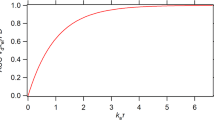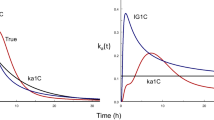Abstract
Equations for the mean residence times in the body (MRT) and AUMC/AUC of a drug and its metabolite have been derived for an oral drug undergoing first-pass and linear reversible metabolism. The mean residence times of the drug or interconversion metabolite in the body after oral drug are described by equations which include the mean absorption time (MAT), the mean residence times of the drug or metabolite in the body after intravenous administration of the drug, the fractions of the dose entering the systemic circulation as the parent drug and metabolite, and the systemically available fractions of the drug (F p p) or metabolite (F m p). Similarly, the AUMC/AUC of the drug and metabolite after oral drug can be related to the MAT, ratios of the fraction of the dose entering the systemic circulation to the systemically available fraction, the first-time fractional conversion of each compound, and AUMC/AUC ratios after separate intravenous administration of each compound. The F p p and F m p values, in turn, are related to the first-pass availabilities of both drug and metabolite and the first-time fractional conversion fractions. The application of these equations to a dual reversible two-compartment model is illustrated by computer simulations.
Similar content being viewed by others
REFERENCES
J. Mann and E. Gurpide. Generalized rates of transfer in open systems of pools in the steady state. J. Clin. Endocrinol. 26:1346–1354 (1966).
J. J. DiStefano. Concepts, properties, measurement, and computation of clearance rates of hormones and other substances in biological systems. Ann. Biomed. Eng. 4:302–319 (1976).
J. H. Oppenheimer and E. Gurpide. Quantitation of the production, distribution, and interconversion of hormones. In L. J. Degroot (ed.), Endocrinology, Vol. 3, Grune and Stratton, New York, 1979, pp. 2029–2036.
J. G. Wagner, A. R. DiSanto, W. R. Gillespie, and K. S. Albert. Reversible metabolism and pharmacokinetics: Application to prednisone and prednisolone. Res. Commun. Chem. Pathol. Pharmacol. 32:387–405 (1981).
S. Hwang, K. C. Kwan, and K. S. Albert. A linear model of reversible metabolism and its application to bioavailability assessment. J. Pharmacokin. Biopharm. 9:693–709 (1981).
S. S. Hwang and W. F. Bayne. General method for assessing bioavailability of drugs undergoing reversible metabolism in a linear system. J. Pharm. Sci. 75:820–821 (1986).
W. F. Ebling and W. J. Jusko. The determination of essential clearance, volume, and residence time parameters of recirculating metabolic systems: The reversible metabolism of methylprednisolone and methylprednisone in rabbits. J. Pharmacokin. Biopharm. 14:558–599 (1986).
L. Aarons. Mean residence time for drugs subject to reversible metabolism. J. Pharm. Pharmacol. 39:565–567 (1987).
H. Cheng and W. J. Jusko. Mean residence times of multicompartmental drugs undergoing reversible metabolism. Pharm. Res. 7:103–107 (1990).
S. Nagamine, T. Otawa, H. Nakae, and S. Asada. Estimation of the rates of available fraction for some 4-substituted acetophenone derivatives in the rats: Reversible drug-metabolite pharmacokinetics. Chem. Pharm. Bull. 36:4612–4618 (1988).
H. Cheng and W. J. Jusko. Constant-rate intravenous infusion methods for estimating steady-state volumes of distribution and mean residence times in the body for drugs undergoing reversible metabolism. Pharm. Res. 7:628–632 (1990).
H. Cheng and W. J. Jusko. Mean interconversion times and distribution rate parameters for drugs undergoing reversible metabolism. Pharm. Res. 7:1003–1010 (1990).
J. Eisenfeld. On mean residence times in compartments. Math. Biosci. 57:265–278 (1981).
D. G. Covell, M. Berman, and C. Delisi. Mean residence time—Theoretical development, experimental determination, and practical use in tracer analysis. Math. Biosci. 72:213–244 (1984).
M. L. Rocci and W. J. Jusko. LAGRAN program for area and moments in pharmacokinetic analysis. Comp. Prog. Biomed. 16:203–216 (1983).
D. J. Cutler. Theory of the mean absorption time, an adjunct to conventional bioavailability studies. J. Pharm. Pharmacol. 30:476–478 (1978).
S. Riegelman and P. Collier. The application of statistical moment theory to the evaluation of in vivo dissolution time and absorption time. J. Pharmacokin. Biopharm. 8:509–534 (1980).
M. Gibaldi and D. Perrier. Pharmacokinetics, 2nd ed., Marcel Dekker, New York, 1980, p. 413.
K. K. H. Chan and M. Gibaldi. Effects of first-pass metabolism on metabolite mean residence time determination after oral administration of parent drug. Pharm. Res. 7:59–63 (1990).
Author information
Authors and Affiliations
Rights and permissions
About this article
Cite this article
Cheng, H., Jusko, W.J. Mean Residence Time of Oral Drugs Undergoing First-Pass and Linear Reversible Metabolism. Pharm Res 10, 8–13 (1993). https://doi.org/10.1023/A:1018904509178
Issue Date:
DOI: https://doi.org/10.1023/A:1018904509178




